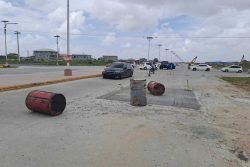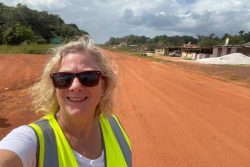By Wintress White and Joy Marcus
Protecting the rights of women and children is always an important obligation of any government. In Guyana, violence against women and children has been a serious problem for many years. In addition, women’s equality overall remains lacking; there are still strong cultural and religious traditions in Guyanese society that promote male domination over women and prevent women and girls from fully enjoying their human rights. In this context, the government has a responsibility to play a leadership role in terms of re-shaping harmful societal attitudes, promoting gender equity, and protecting women and children. This obligation however, remains largely unmet.
The current government of Guyana – like the previous one – has several female Ministers and does claim a commitment to women’s rights; however, the reality for women and children on the ground remains largely unchanged. Laws on the books and lip service to empowerment and equity aside – Guyanese women and children remain extremely vulnerable and disadvantaged, compared to their male counterparts. Specifically, serious flaws in the judicial system remain – although women currently hold the top positions of the Guyanese judiciary. Sexual violence matters remain under-reported, inadequately investigated, and conviction rates woefully low.

Although there is a Sexual Offences Act and a National Task Force designated to assist with its proper implementation, the fact is that that entity is largely non-functional. In addition, law enforcement officers are themselves often perpetrators of violence against women and children and also regularly collude with victimizers to thwart the course of justice. This has created a culture of distrust among women and children of the systems that are supposed to protect them. Other constitutional structures that are supposed to be in place to protect women and children such as the Human Rights Commission also have not yet been set up by the current government.
In other areas such as health and employment, the rights of women and children remain significantly unmet. Maternal and infant mortality rates in Guyana remain among the highest in the world, with little progress made towards improving these outcomes and consistent failure on the part of public healthcare facilities around the country to safeguard the wellbeing of women and children. In the hinterland regions in particular, pregnant women are not even receiving regular antenatal HIV testing – something which has been the gold standard of care for over two decades in other parts of the world. Hospitals are routinely out of stock of basic medications like saline, Panadol, and oral rehydration solution – key for treating diarrhea among young children- a major cause of infant mortality. That such crucial yet basic supplies and standards remain lacking in Guyana in 2017 point to deep and systemic failures on the part of government entities to function in ways that protect and safeguard women and children.
In terms of employment, the present government has not embarked on any real job creation; instead their main focus has been on entrepreneurship and micro-enterprise – areas in which Guyanese women have long engaged but which have not provided enough resources to lift generations out of poverty. Women in Guyana are routinely overworked and underpaid, and face regular harassment (sometimes sexual) and exploitation – on the streets as well as at their workplaces. Recent attempts by Junior Minister Scott to protect women security guards instead further entrenched notions of paternalism and female victimhood; instead of implementing systems to halt and hold the perpetrators of abuse and harassment accountable for their actions, the Minister suggested that the women should not do night work. Attitudes like this from government officials highlight the fact that women and children are still seen as second class citizens in Guyana, and that male perpetrators of abuse and violence against them are not held accountable – fueling a culture of inequity and impunity. Employed mothers are also not provided with any consideration such as affordable and accessible childcare facilities or breastfeeding breaks at their workplace, and children are regularly left alone in unsafe situations by parents (often mothers) who have no other alternatives. Instead of supporting families in ways that would strengthen and keep them intact, governmental agencies instead regularly remove children from their parents, without regard for the additional emotional trauma they are thereby inflicting. The case of the George brothers who burnt to death while at the drop-in center run by the Child Care and Protection Agency – a government facility – highlights this lack of true consideration for vulnerable women and children by the entities that are supposed to be protecting them. Lack of affordable housing remains another major problem affecting women and children in Guyana – especially those who are economically marginalized. Failure of the land allocation system to provide house lots to families in a timely and affordable manner has led to widespread squatting and confrontations between families – often female headed households – and government entities, most recently, the demolition crew from the Ministry of communities in A Field Sophia.
Groups such as elderly women, women and children with disabilities, and non-gender conforming women (members of the lesbian, bisexual, and transgender community) are also underserved by government agencies. There are no specific legal protections for lesbian, bisexual, and transgender women and stigma, discrimination, and violence against these individuals remains widespread in Guyana. There is little to no recourse to justice for victims of such hate crimes, and many suffer in silence. Poverty, depression, suicidal ideation, and other negative mental health states are common in this community, with many persons struggling to survive economically. Although this current government has increased the old age pension, it is still a pittance and totally inadequate to meet living expenses, especially since the subsidy on water and electricity has been removed for elders, adding onto their costs. A similar situation exists for women and children with disabilities – while public assistance for them has increased, it does not reflect the true cost of living and is largely insufficient to meet persons’ daily needs. Women (and men) who are elderly or on public assistance are unable to access good medical care when free public facilities lack needed medications or testing facilities.
The minimum wage of $44,000GYD – also slightly increased by this government – is still not enough for a small family of four persons to live on, and it is the women who have to do the work of stretching the money. That the government points to these slight increases as proof of their caring for and commitment to providing a better life for all Guyanese would be laughable if insult had not been added to injury by the Parliamentarians giving themselves a significant salary increase six months after they came into power.
In some of the hinterland communities there are no police stations, magistrates’ courts , schools and health centres. Women who are abused by their husbands/partners have to suffer and sometimes die because there is no police station in the community and the nearest one is sometimes quite a long distance away with lots of bushes where the abuser could lie in wait for them. Some children have to walk distances away to go to school and when they are housed in dormitories there is sometimes lack of food and proper supervision. Hinterland regions often have just one child welfare or child protection officer for the entire area.
As Guyana is a signatory to the Convention for the Elimination of Discrimination against Women, we can also use the concluding observations /recommendations made by the expert committee in response to the State’s report to measure our progress on a number of fronts. The most recent observations, responding to the 2012 report submitted by the previous administration are still a useful yardstick since little has been done to improve the situation of women in a number of areas. Some selected recommendations from the committee are:
“….9. The Committee calls on the State party to:
(a) Take the necessary steps to ensure the adequate dissemination of the Convention and the Committee’s general recommendations among all stakeholders, including Government ministries, parliamentarians, the judiciary, law enforcement officers, and religious and community leaders, so as to create awareness of women’s human rights and establish firmly in the country a legal culture supportive of women’s equality and non-discrimination; and
(b) Take all appropriate measures to enhance women’s awareness of their rights and the means to enforce them, including through providing women with information on the Convention in languages accessible to them in all regions of the State party, in particular in hinterland and rural areas and among the Amerindian communities, emphasizing ways to utilize the available legal remedies for violations of their rights. …
- The Committee encourages the State party:
(a) To clearly define the mandate and the responsibilities of the national machinery for the advancement of women and to expeditiously strengthen that machinery by providing it with adequate human, financial and technical resources for it to coordinate and work effectively for the promotion of gender equality and gender mainstreaming;
(b) To provide training on women’s rights to women and men working in the national machinery for the advancement of women; and
(c) To strengthen its impact assessment of measures taken so as to ensure that such measures achieve their goals and targets…
- The Committee urges the State party:
(a) To accord high priority to the full implementation of the Sexual Offences Act and to put in place comprehensive measures to prevent and address violence against women and girls, recognizing that such violence is a form of discrimination against women and constitutes a violation of their human rights under the Convention and a criminal offence and ensuring that women and girls who are victims of violence have access to immediate means of redress and protection and that perpetrators are prosecuted and punished, in accordance with general recommendation No. 19 of the Committee;
(b) To provide mandatory training for judges, prosecutors and law enforcement officials in procedures to deal with women victims of violence; (We should note that the judiciary have been very active in this regard)
(c) To encourage women to report incidents of domestic and sexual violence by destigmatizing victims and raising awareness about the criminal nature of such acts;
(d) To provide adequate assistance and protection to women victims of violence by strengthening the capacity of shelters and crisis centres, especially in hinterland areas, and enhancing cooperation with non-governmental organizations that provide shelter and rehabilitation to victims;
(e) To collect statistical data on domestic and sexual violence disaggregated by sex, age and relationship between the victim and perpetrator; and
(f) To provide effective protection against violence and discrimination against all groups of women through the enactment of comprehensive anti-discrimination legislation that includes the prohibition of all forms of discrimination against them and the decriminalisation of consensual adult same sex relations as indicated in the oral statement of the delegation. …”
In conclusion, the Guyana government continues to fail the women and children of Guyana – especially those who are economically marginalized- on multiple fronts. With all the talk in their manifesto about women’s rights and equality, they are yet to submit a report to CEDAW due since 2016 on the current state of women and children in Guyana.
This article was submitted by the Red Thread organization










